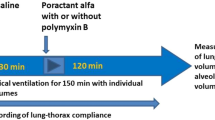Abstract
SEVERAL experiments show a correlation between the number of mast cells in a tissue and its content of histamine1, and it is possible to obtain histamine from isolated mast granules3. Furthermore, alterations of mast cells have been described under conditions in which liberation of histamine occurs in the dog, rat and mouse3. We have found that similar changes can be produced in guinea pig lung mast cells by means of anaphylactic shock, but not by the action of compound 48/80. Male guinea pigs weighing 300–450 gm. were used throughout. Groups of five animals each were studied. Group I: animals sensitized by injecting 100 mgm. of commercial egg albumin intraperitoneally and 100 mgm. subcutaneously; anaphylactic shock was induced three weeks later by intracardiac injection of 100 mgm. of the antigen in 1 ml. of 0.85 per cent sodium chloride. Group II: sensitized animals killed after shock was induced by intracardiac injection of 200γ of histamine. This group was chosen in order to obtain lungs in similar conditions (emphysematous) to those of group I. Group III: animals injected through the intracardiac route with 0.5 mgm. of compound 48/80. The animals from these three groups were killed by bleeding from the jugular vein when breathing had practically stopped. Group IV : animals killed by a blow on the head and bled from the jugular vein.
This is a preview of subscription content, access via your institution
Access options
Subscribe to this journal
Receive 51 print issues and online access
$199.00 per year
only $3.90 per issue
Buy this article
- Purchase on Springer Link
- Instant access to full article PDF
Prices may be subject to local taxes which are calculated during checkout
Similar content being viewed by others
References
Riley, J. F., and West, G. B., J. Physiol., 117, 72P (1952); 120, 528 (1953). Riley, J. F., Science, 118, 3064 (1953).
Mota, I., Beraldo, W. T., Ferri, A. G., and Junqueira, L. C. U., Nature, 174, 698 (1954). West, G. B., J. Pharm. Pharmacol., 7, 80 (1955).
Wilander, O., Scand. Arch. f. Physiol., Supp. 15 (1939). Jaques, L. C., and Waters, E. T., J. Physiol., 99, 454 (1941). Mota, I., and Yoneda, S., paper presented to Soc. Brasileira Anat. (1952). Riley, J. F., Proc. Soc. Exp. Med., Dundee Meeting (1952). Riley, J. F., J. Path. Bact., 65, 471 (1953). Mota, I., thesis, Univ. of São Paulo (1953). Mota, I., Beraldo, W. T., and Junqueira, L. C. U., Proc. Soc. Exp. Biol. Med., 83, 455 (1953).
Snedecor, G.W., “Statistical Methods” (Ames, Iowa State College Press, 1946).
Mota, I., Beraldo, W. T., Ferri, A. G., and Junqueira, L. C. U., Histamine Symposium, Ciba Foundation (London, April 1955)(in the press).
Feinberg, S. M., and Sternberger, L. A., J. Allergy, 26, 170 (1955).
Feldberg, W., and Mongar, J. L., Brit. J. Pharmacol. Chemother., 9, 197 (1954).
Author information
Authors and Affiliations
Rights and permissions
About this article
Cite this article
MOTA, I., VUGMAN, I. Effects of Anaphylactic Shock and Compound 48/80 on the Mast Cells of the Guinea Pig Lung. Nature 177, 427–429 (1956). https://doi.org/10.1038/177427a0
Issue Date:
DOI: https://doi.org/10.1038/177427a0
This article is cited by
-
Maturation of mast cell progenitors to mucosal mast cells during allergic pulmonary inflammation in mice
Mucosal Immunology (2015)
-
Attenuation of antigen-induced bronchospasm by fenoterol in the guinea-pig
Agents and Actions (1984)
-
Mast cells isolated from guinea-pig lung: characterization and studies on histamine secretion
Agents and Actions (1983)
-
Histamine release from human pulmonary mast cells
Agents and Actions (1982)
-
Isolation and some properties of mast cells from the mesentery of the rat and guinea pig
Agents and Actions (1980)
Comments
By submitting a comment you agree to abide by our Terms and Community Guidelines. If you find something abusive or that does not comply with our terms or guidelines please flag it as inappropriate.



